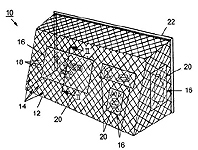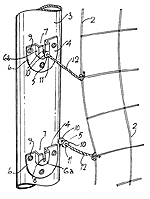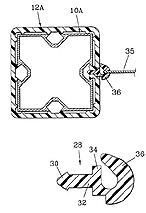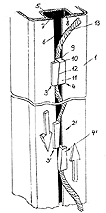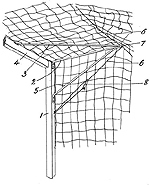The Football Goal
3. The goal net
Patents for the net of the goal may be based on the specific cut of the net or special netting and finishing. However, it is also possible to be granted a patent for the net of a goal if it consists of materials which had originally not been intended for such use.
Today, a net consists of durable synthetic fibre such as polyamide. Formerly, a large variety of different materials or combinations of those materials were used to achieve satisfactory weather resistance and mechanical strength.
3.1 The production of goal nets
Formerly, textile cords and iron wires, and alloy wires were also used as net materials. Textile nets had to be taken down every time after the game since they were not weatherproof. Iron wire was quite sturdy but it rusted through rather quickly and alloy wire did not have the necessary tear resistance when hit by the ball. All these materials had major disadvantages and posed a high risk of injury for the players, when they came into close contact with the goal wire netting during the game.
DE-PS 10 20 916 using rubber cords for goal nets constitutes a real innovation. It explicitly mentions the use of rubber salvage so that it can be classified as an innovative recycling patent although the product will probably be in rather low demand.
DE-AS 25 39 342 provides a time-saving and low-cost production technique for a net. It describes how all sections of a goal net can be produced in one step on a netting machine. Until then, at least three net sections had to be produced separately and had to be connected in an additional step.
Since the original purpose of the net is to enclose the ground behind the goal, the idea to use the net as an advertising space ? while keeping its net structure ? indeed constitutes an innovation. EP 1 241 654 A1 describes the attachment of transparencies which may be imprinted with the product advertised (Figure 9). WO 2004/10 96 31 A1 shows how lettering is made visible directly by thickened net strings at specific places in the net and WO 2007/051 885 A2 shows how logos can be knotted into the net for advertising purposes.
| Publication number | Year | Title | Brief description |
|---|---|---|---|
| WO 2007/051 885 A2 | 2007 | Advertising net for goals and support for same | Additional ropes knotted into goal net, the overall composition of the ropes forming eg an advertising logo |
| WO 2004/10 96 31 A1 | 2004 | Netz mit einer optisch sichtbaren Beschriftung sowie Verfahren zum Aufbringen von sichtbaren Beschriftungen auf Netze | Strings of the net are thickened in suitable places to apply visible lettering |
| EP 1 241 654 A1 | 2001 | Ballfang- oder Trennnetz | Transparencies fastened to net to carry advertising |
| DE-AS 25 39 342 | 1975 | Tornetz für Fußballtore, Handballtore od. dgl. | Goal net that can be manufactured on a netting machine in a single production step |
| DE-PS 10 20 916 | 1954 | Fußballtornetz | Weather-resistant rubber goal net with high elasticity properties |
3.2 The net support
Before the net can be tightened it must be fastened to the goal posts and crossbar. A large variety of fixing devices exist for this purpose.
Even in the mid-1950s loops were driven into the wood of the rear face of the goal post and the net was tied to the loops by means of additional cords.
WO 97/39807 A1 shows that even today inventors are still concerned with modifications of that system. The loop was simply replaced by a fixing device consisting of a male component (fastened to the net) and a female component (fastened to the post). An additional cord is still used (Figure 10).
It is also common to fasten nets to the goal frame by means of straps without having to apply any specific preparatory measures (eg. DE 195 14 861 C1).
More recently aluminium extrusions have mostly been used with a track on the rear side to attach the net by using a technique that is also used for curtain rails with the difference that the relevant attachment parts can be fastened by screws or wedge clips.
These attachments have hooks (eg. EP 0 726 084 A1, Figure 11) or wedge clips (eg. DE 299 22 198 U1, Figure 12) to hook in or fasten the net.
DE 100 25 333 C1, DE 89 07 486 U1, DE 89 05 626 U1, FR 2 560 774 A1 and US 5 476 266 A provide further examples for these techniques, some of them are hybrid systems. The original idea is particularly well explained in DE 83 33 703 U1.
A new development is the goal frame profile (EP 3 124 086 A2) with a profile groove in which the goal net can be fastened by a safety profile.
| Publication number | Year | Title | Brief description |
|---|---|---|---|
| DE 100 25 333 C1 | 2000 | Vorrichtung zum lösbaren Halten von Seilen oder Leinen an Gegenständen | Football goal net attachments |
| DE 299 22 198 U1 | 1999 | Netzhaltevorrichtung | Device for wedging the net in a track on the rear side of the extrusion |
| WO 97/39 807 A1 | 1996 | A net fixing device | Fixing device for mounting a net on a goal post with a female component fastened to the goal post by screws and a male component secured to the net by a cord |
| EP 0 726 084 A1 | 1995 | Dispositif de protection d?un élément tubulaire et élément ainsi obtenu | Hooks to fasten nets to aluminium extrusions with track on the rear side |
| DE 195 14 861 C1 | 1995 | Gurt und Verfahren zur Befestigung eines Gegenstandes, insbesondere eines Netzes | Special straps to directly fasten the net to the frame without the need for any special preparatory measures |
| US 5 476 266 A | 1994 | Net fastener device | Net fastener device functioning like a curtain rail with wedged hanger connectors |
| DE 89 07 486 U1 | 1989 | Netzhalter | Net attachment clips for use with net edge rope, pushed in the channel on the rear side of the extrusions |
| DE 89 05 626 U1 | 1989 | An einem Tornetz zu befestigender Halter zum lösbaren Verankern an mit einer hinterschnittenen Führungsnut versehenen Torpfosten oder Torlatten | Net clips attached to net to allow installation and removal of net by securing clips to guiding track on the rear side of the extrusions that form the uprights or crossbar |
| FR 2 560 774 A1 | 1984 | Dispositif d?accrochage des filets sur les buts de sport | Attachment of edge rope of goal net using extrusions with a track on rear side |
| DE 83 33 703 U1 | 1983 | Halter zum Einhängen von Tornetzen | Device for fastening net to extrusion with a track on rear side; device held in place by screw |
| DE-PS 704 750 | 1939 | Halter für Fußballtornetze | Elastic rods in the upper parts of the two goal posts to push back the goal net which is fastened to the crossbar |
3.3 Net tensioning systems
After the net is attached to the goal frame it is necessary to tighten the net in the area behind the goal to prevent it from hanging down to the goal line like a curtain and interfering with the goal keeper.
In some cases, the net is also tighten by applying structural measures to the goal, for instance, an elastic rod in the upper part of the goal post (DE-PS 704 750), a net support elbow bracket (above mentioned DE-OS 20 34 663), a tensioning rod that can be secured to the post (DE-GM 70 09 701) or a so-called retaining frame for securing goal nets, shown in DE 44 27 335 A1.
Net tensioning poles installed at a distance from the goal frame in the space behind the goal are also common (eg. DE 298 18 692 U1).
The fundamental idea on which all the above documents are based was already described by Henry John Bowden and Jesse Pennington in GB 224 072 A in 1923: it proposes a triangulated system in the angle of post and crossbar with a loop on top of the triangulated system to support the net and adjust the tension of the tie (Figure 13).
| Publication number | Year | Title | Brief description |
|---|---|---|---|
| DE 298 18 692 U1 | 1998 | Spannstange mit Umhüllung | Tensioning pole to tighten goal net in the area behind the goal |
| DE 44 27 335 A1 | 1994 | Netzhaltebügel | Retaining frame fastened to the upper goal angle to allow tightening the net at the rear of the goal |
| DE-GM 70 09 701 | 1970 | Vorrichtung zum Aufhängen und Spannen eines Netzes | A tensioning rod that can be secured to the post and pulls the net back |
| DE-OS 20 34 663 | 1970 | Fuß- oder Handballtor | Collapsible goal made of round posts with net support elbow bracket used as securing contrivance for two post components |
| DE-PS 704 750 | 1939 | Halter für Fußballtornetze | Elastic bars in the upper part of the two uprights to push the net back which is fastened to the crossbar |
| GB 224 072 A | 1923 | Improvements in or relating to Net Supporting Means for Games and Sports | Triangulated system in the angle of post and crossbar with a loop on top of the triangulated system to support the net and adjust the tension of the tie |

